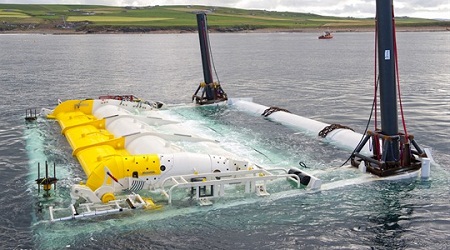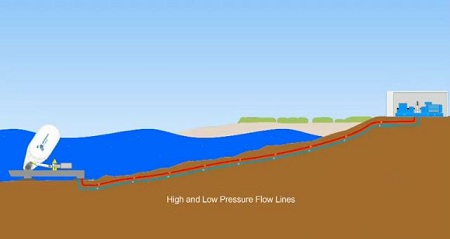“He was a bold man that first ate an oyster,” is the quote attributed to Jonathan Swift. But what about the wave power company that first deployed an Oyster? It’s an unlikely looking energy generator, the Aquamarine Power Oyster, with its big hinged flap, but the company appears to be making steady progress with it.
The latest news on the Oyster out of Scotland is that the government has approved Aquamarine’s plan to put three of the 800-kilowatt devices at the European Marine Energy Centre in Orkney, where last September the company deployed a single Oyster. Though still termed a demonstration project, the government said the set of three Oysters would comprise Scotland’s “first near shore commercial wave power array” to be connected to the National Grid.

On its blog, Aquamarine said the approval was a key step in turning Scotland’s big marine power ambitions into reality.
“It paves the way for us to continue working with Marine Scotland to further streamline the consents process and gain all the necessary consents for our 200-megawatt (MW) commercial wave energy site in Orkney, and our 40-MW site on Lewis,” the company said.
The Oyster 800 is the updated version of the original Oyster 1, with increased power output, simplified installation and easier routine maintenance, according to the company. Some of the gains are explained by the device’s new shape: it’s wider than the original, helping it capture more wave energy, and it sits atop two seabed piles rather than the original four.
So how exactly does the Oyster work? First, it’s attached to the seabed at depths of between about 30 and 50 feet about a quarter-mile offshore. Its hinged flap, which is almost entirely underwater, pitches back and forth in the waves, driving hydraulic pistons that push high-pressure water onshore via a subsea pipeline to drive a conventional hydro-electric turbine.

With Scotland playing a key role, the United Kingdom is making substantial investments in marine-based energy production. And according to the Carbon Trust, by 2025, the best marine power sites in the United Kingdom could produce energy at a price competitive with nuclear and onshore wind power. The Carbon Trust has also forecast that the nation could capture nearly 25 percent of the world’s marine energy market by 2050.
“This array will supply more than 1,000 homes with clean energy, and should the demonstrator be successful the technology being developed here will power hundreds of thousands more homes in future,” Energy Minister Fergus Ewing said in a statement. “Scotland has unparalleled natural resources, with a tenth of Europe’s wave power, and these new devices will help us to fully harness the huge energy resources around our own coast and contribute to global efforts to expand clean, green electricity generation.”